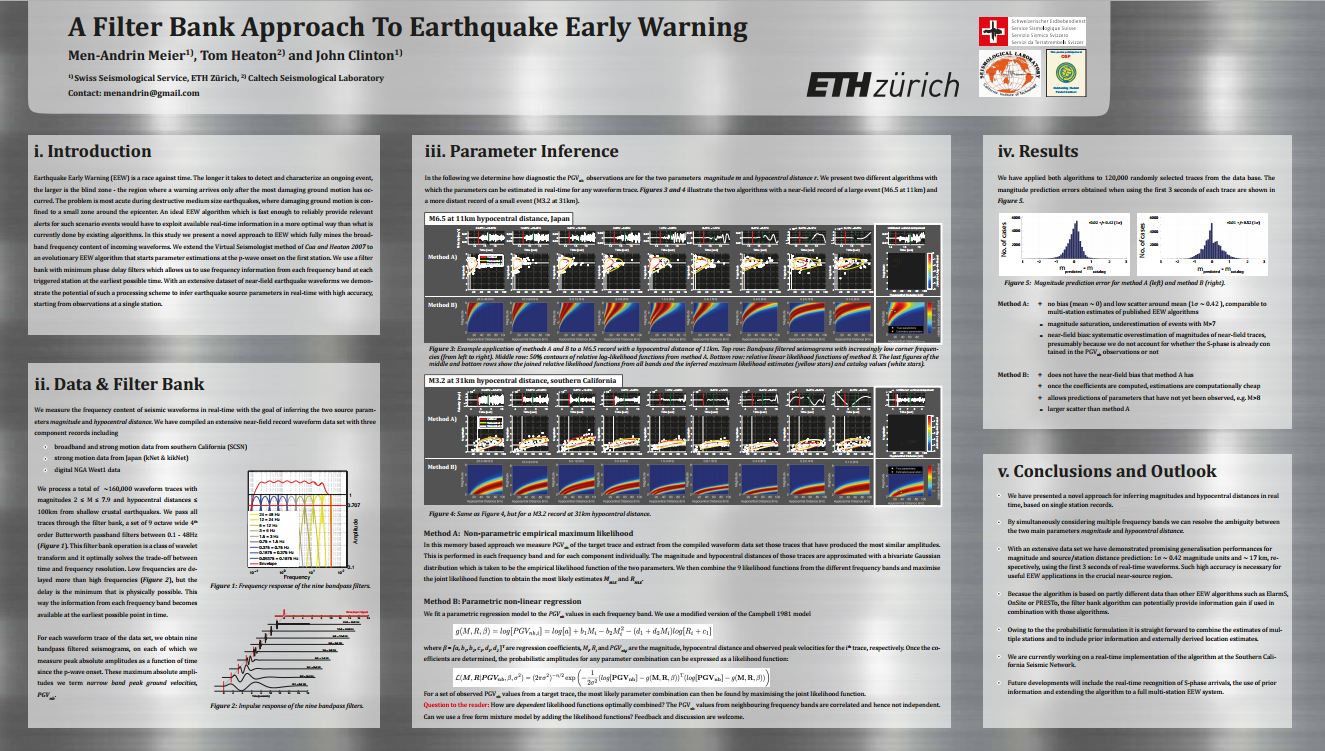This page features interviews with young seismologists. Find out who these scientists are and what is their current research or latest discovery.
Men-Andrin Meier: Men-Andrin Meier is one of the 3 winners of the 2014 Outstanding Student Poster Award selected by the Seismology Division. His poster is titled: A Filter Bank Approach To Earthquake Early Warning which he co-authored with Heaton and Clinton. The following is an interview with Men-Andrin about his career so far.

Age: 30
Current position: PhD student
Current institution:
ETH Zurich, Swiss Seismological Service
Profile website address: here
What did you study/work on before your PhD:
I did a BSc and a MSc at ETH Zurich.
My BSc thesis investigated whether the mantle plume that presumably feeds the Icelandic volcano system can be imaged via characteristic Samarium/Neodymium and Lutetium/Hafnium isotope signatures. The answer was a pretty clear no. 🙂 The study led to an article published in Journal of Petrology: Melting of a Two-component Source beneath Iceland.
In my MSc thesis we tried to establish to what extent secondary coseismic stress changes played a role for the triggering of aftershocks during the 1992 Landers, California, earthquake sequence. Our findings were published in Journal of Geophysical Research: A search for evidence of secondary static stress triggering during the 1992 Mw7.3 Landers, California, earthquake sequence. There were no easy answers. Absolute secondary stress change levels are, in a majority of cases, comparable or larger than stress change levels produced by the main shocks. But whether the secondary stress changes are predominantly positive, so that stress contributions from multiple small earthquake sum up to significant cumulative stress levels is to a large part hidden by data uncertainties.
What is your current scientific investigation? What methods do you apply?
We are currently working on a memory based empirical Earthquake Early Warning approach. We use a causal filter bank to perform real-time frequency analyses of incoming seismic waveforms and investigate how diagnostic the time dependent frequency content is for an earthquake’s magnitude and source/station distance. We use the frequency ‘pattern’ we observe in a real-time waveform to find ‘best’ matches in a training data set. We then use the (known) source parameters of these best matches to estimate the most likely source parameters of the earthquake that is being recorded. So most of my day I spend on large amounts of waveform processing and likelihood inference methods.
Tell us about your award-winning poster
The poster illustrates our inference method with two example cases and shows our current results. We obtain excellent magnitude predictions with minimum data input, but we underestimate the magnitudes of events with M>6.5. We currently investigate whether this is a physical limit (the earthquake does not know it is going to be M>6.5 at the time we make the inference) or whether it reflects a flaw in our inference method.
What are your comments on EGU-GA 2014
I loved this year’s EGU conference. When I was at the beginning of my PhD I sometimes got really frustrated at conferences because I felt like I did not understand most of the things that were presented. By now I understand most things and it is great to have the opportunity to talk to everyone about their science. Almost everybody is very open and approachable.
What has been the highlight of your career so far?
A four-month visit of the Caltech SeismoLab in 2013 to collaborate with Tom Heaton on the EEW algorithm.
Where do you see yourself in 5 years time?
On the seismic hazard committee for Springfield’s Nuclear Power Plant, haha. My past prediction record tells me I should not be doing 5 year-long forecasts…
Philipp Kempf: Winner of the 2013 Outstanding Student Poster Award for the poster entitled: 1960 Valdivia earthquake tsunami deposits from two coastal lakes and preliminary results for an extended paleo-tsunami record of south-central Chile.
[googleapps domain=”docs” dir=”file/d/0BzREp5JTpWqYTklOYlJoMUJHYjA/preview” query=”pli=1″ width=”640″ height=”385″ /]
Introduction to Seismoblog:
[googleapps domain=”docs” dir=”file/d/0BzREp5JTpWqYUkxfdlZKRXlqNFE/preview” query=”pli=1″ width=”640″ height=”385″ /]

